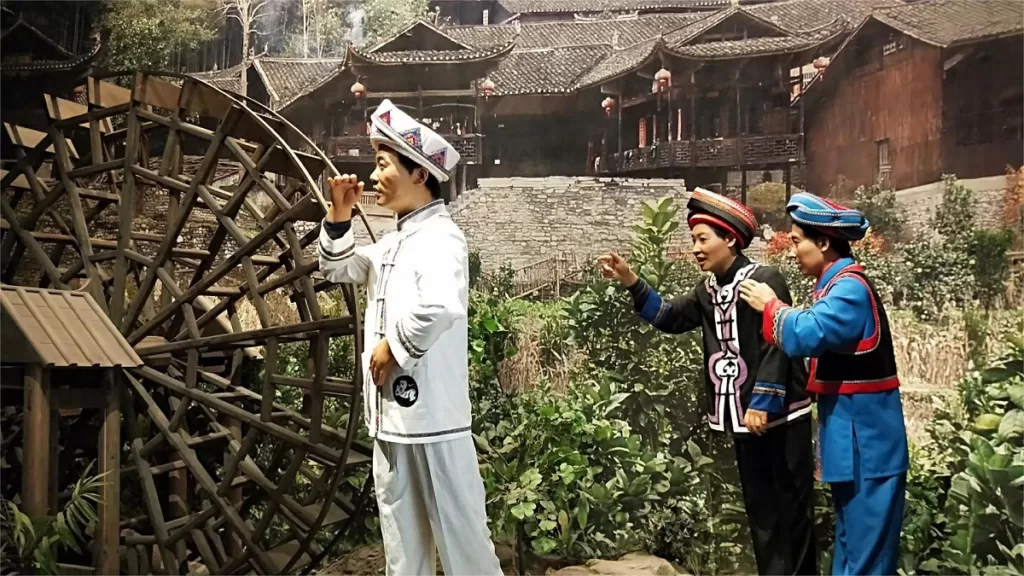Tujia Daughter City (土家女儿城) in Enshi combines ancient architecture with Tujia stilt houses, showcasing the rich cultural heritage of the Tujia ethnic group. This vibrant destination features 300 shops, 500 themed guesthouses, 30 distinctive dining establishments, 40 delightful snack vendors, an 8,000-square-meter landscaped lawn, a 10,000-square-meter comprehensive sports center, and the indoor theatrical marvel, Daughter City Grand Theater. Additionally, it boasts Hubei province’s largest water park.
The streets of Daughter City are intricately designed, following the natural contours of the mountains and flowing with the water, paved with gray angular gravel. Daughter Street, positioned at the heart of the ancient city, serves as the representative thoroughfare. It is not only the bustling street of Daughter City but also one of the thriving commercial zones in Enshi, epitomizing the city’s economic dynamism. With its unique blend of ancient charm and modern amenities, Tujia Daughter City stands as a testament to the Tujia people’s traditions and customs while providing a lively and diverse experience for visitors.
Table of Contents
- Basic Information
- Location and Transportation
- Custom Displays in Tujia Daughter City
- Map of Tujia Daughter City
- Vlog about Tujia Daughter City
- Useful Tips Summarized from Reviews
- Other Attractions in Enshi Urban Area
Basic Information
| Estimated Length of Tour | 1 – 2 hours |
| Ticket Price | Free |
| Opening Hours | 24 hours a day throughout the year |
| Telephone Number | 0086-0718-8028699 |
Location and Transportation
Tujia Daughter City is situated in the Qiliping area of Enshi City, Hubei Province, China. The precise address is 41 Ma’anshan Road. This cultural destination is located within the urban area of Enshi and serves as a showcase of Tujia ethnic traditions and customs.
To get there, Tourists can take bus 12, 28B, 31, 39, or 39B and get off at Nv’ercheng Stop (女儿城站)
Custom Displays in Tujia Daughter City
Shuai Wan Jiu (Smashing Bowl Wine)

“Shuai Wan Jiu” originates from ancient Tujia customs and was a ceremonial drink performed before Tujia sons and daughters went off to battle. According to folklore, in a certain era, two Tujia tribal leaders or brothers harbored grievances. In a bid for the survival and development of their people, they decided to reconcile. They drank together to signify future friendship and harmony. Once consumed, they shattered the bowls, symbolizing the end of grievances and showcasing their magnanimity and boldness.
Bai Shou Wu (Hand Gesture Dance)

The “Bai Shou Wu” (Hand Gesture Dance) has multiple origins. One belief is its roots in religious rites and ancestral veneration. Tujia people deeply respect their ancestors and honor their leaders. To commemorate their achievements, they created this dance. Another theory links it to wartime activities, where legends tell of leaders using dance and song to boost morale or drive away homesickness among troops. Following victorious battles, this dance transitioned into a folk tradition. Additionally, some attribute it simply to the Tujia people’s inherent love for song and dance, considering it an artistic expression for self-entertainment. Lastly, it’s speculated that ancient Tujia ancestors utilized hand gestures for physical conditioning against natural elements or invasions, evolving gradually into the elaborate Hand Gesture Dance.
Tujia Daughter’s Festival

Often referred to as the Eastern Valentine’s Day or Tujia Valentine’s Day, Tujia Daughter’s Festival typically spans from the 7th to the 12th day of the lunar calendar’s 7th month. Originating in the Enshi region, particularly around Shihuiyao and Dashanding area, it has evolved into a regional ethnic festival. A distinctive feature of this festival is its use of songs as a medium for autonomous mate selection. Young maidens, as well as married women, participate to find potential partners or meet with past lovers, expressing their feelings through song.
During the Daughter’s Festival, young women dress in their most beautiful attire, layering garments with varying lengths – longer ones inside and shorter ones outside, each layer visible. They adorn themselves with their finest gold and silver jewelry, creating a dazzling spectacle.
Tujia Cry Marriage

Another intriguing Tujia custom showcased in the city is the “Tu Jia Zu Ku Jia” or Tujia Cry Marriage. When a Tujia daughter is to be married, she must display the ability to cry in a touching and moving manner, a practice known as “cry marriage.” A girl who cries eloquently is regarded as an intelligent and capable bride. Tujia girls begin learning this art of crying from the age of twelve or thirteen. In the past, those who couldn’t cry were not allowed to marry. The climax of cry marriage occurs on the day before the bride leaves her family. Friends and relatives gather to offer congratulations and bid tearful farewells. The bride’s family invites nine of her best unmarried friends to accompany her in the crying ritual, creating an emotional and memorable farewell scene.
Map of Tujia Daughter City

Vlog about Tujia Daughter City
Useful Tips Summarized from Reviews
Experience Shuaipan Wine: Inside the restaurants, you can experience the tradition of Shuaipan wine, where bowls are ceremonially smashed. However, be cautious during this experience to avoid injury from any glass shards.
Explore the Snack Street: Tujia Daughter City features a snack street where you can explore various local delicacies. However, be aware that due to the high volume of visitors, the snacks may be relatively common in taste. It tends to be crowded, so if you enjoy bustling environments, it’s worth a visit. However, it might be best to avoid visiting during the summer months due to the heat.
Rent Ethnic Costumes for Photos: Many studios within Tujia Daughter City offer the opportunity to rent ethnic costumes for photoshoots. The package prices are similar across different studios, and hiring a photographer can make the process more convenient.
Evening Performances: The highlight of Tujia Daughter City is the evening performance, which starts promptly at 7:30 PM. This performance depicts the traditional Tujia customs and rituals related to courtship and marriage. There’s no need to purchase tickets for the show.
Try Kàng Yàng Yù (炕洋芋): Don’t miss the chance to taste Kàng Yàng Yù, a local delicacy made from Enshi’s small potatoes. It’s renowned for its delicious flavor and is a must-try when visiting Tujia Daughter City.






It is basically an ancient-style commercial city, filled with various artistic performances.
Tujia Daughter City doesn’t seem like a place for those who aren’t keen on photography — it might not be worth the visit. The snacks in the street food market are mostly repetitive, and the heavy commercial atmosphere can be overwhelming. After visiting so many similar places in China, I’ve become somewhat immune to these replica ancient cultural streets. However, during the New Year period, the scenic area did put in some effort to set up a lantern show, and… Read more »
Daughter City is entirely a commercial street. There aren’t many people here even during the off-season, but the architecture is great for photography.
Tujia Daughter City has become a commercialized attraction, but for first-time visitors to Enshi, it still offers a sense of novelty. It’s a great experience for young people; the open-air setting is enjoyable, and you can rent an ethnic costume for just 30.
It’s almost entirely a man-made commercial street, filled with scenes typical of pedestrian streets found in various cities. It doesn’t have the historical depth of Tusi City.
There are so many performances that I couldn’t catch them all. The few restaurants I visited felt quite average.
Daughter City is a free admission attraction that is very commercialized. It showcases the unique customs of the Tujia ethnic group, with shops lining the streets and alleys primarily offering travel photography, snacks, and restaurants. There are many free performances of ethnic song and dance, creating a lively atmosphere. We explored Daughter City from around four in the afternoon until nearly eight, experiencing both the daytime and nighttime views. The number of visitors at night was noticeably greater, with crowds… Read more »
Arrived happily at the Daughter’s City early in the morning, only to find that it was basically a food street plus a man-made amusement park. Other than checking out the houses in the village for some photos and buying some local specialties, there was not much to do. It was not as good as Tusi City.
The performances at Enshi Nv’er City starting at 6.30 in the evening were all quite surprising, so I was eagerly anticipating the final show, considering it was the longest and the highlight. However, after watching the entire program, I felt like I had wasted my time… 1️⃣ The announcement stated the show would start at 7.30, but it didn’t begin until 7.50. 2️⃣ After it started, the actors danced for a few minutes and then began an auction: selecting someone… Read more »
Tujia Daughter City is a large artificial ancient-style commercial street, similar to the commercial snack streets found all over the country. There is a variety of food options with reasonable prices. However, it lacks surprises as it is purely a man-made commercial street. It is relatively large and can be explored in about half an hour for taking photos and dining. The lighting is very nice, making it suitable for a visit at night.